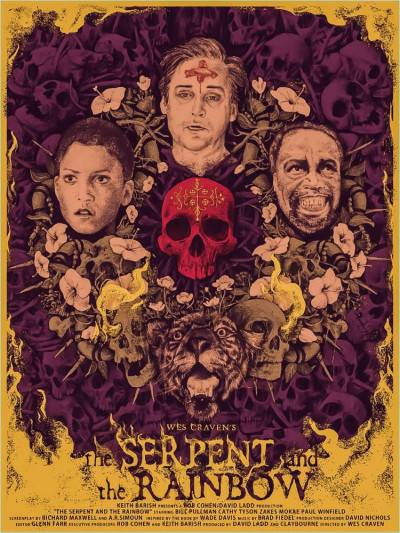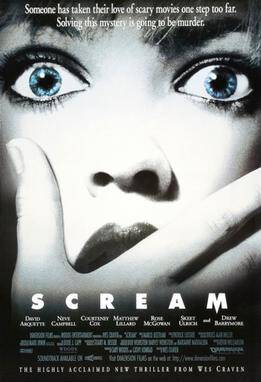Wes Craven has been praised as one of the most imaginative and exciting horror creators in cinema. His legendary Nightmare on Elm Street series which birthed the insidious dream-weaving villain Freddy Krueger, and the hyper-self-aware Scream series which spawned the knife-wielding Ghostface killer, are just two of the many properties Craven has used to scare audiences the world over. Everyone who owns a television can probably tell you at least what these two aforementioned mass-murderers look like, but did you know prolific terror maestro Wes Craven actually started his film career in pornography? Or that Elm Street was actually based on the deathly nightmares of Cambodian refugees who had witnessed the American bombing of Cambodia?
Here we take a look at some of the most influential, and also the more obscure of Wes Craven’s directorial works, in order to pay tribute to and properly learn about a man who caused more sleepless nights than European Techno.
Last House On The Left (1972)
Craven clearly wanted to shock the world from the get-go. His first horror outing centred around two girls looking for drugs after attending a concert in the city. They run into a gang of escaped convicts who kidnap them for a night of rape, torture and their eventual muder. When the convicts later hide out at the home of one of the murdered girls, her parents soon work out what happened and plot their revenge. Last House managed to land itself on the Video Nasties list and was actually refused a certificate for cinema release by the British Board of Film Censors for its depictions of horiffic sadism and sexual violence.
The script, written by Craven in 1971, was originally intended to be a hardcore pornographic feature before filming began, whereupon it was decided that a much softer approach would be taken. One can only imagine what the original idea had in store for viewers. The story is inspired by Ingmar Bergman’s Swedish film The Virgin Spring (1960), which in turn is based on a Swedish ballad, Töres döttrar i Wänge. Who would’ve thought such classic and artistic inspiration could have gone into what is now an infamous rape/revenge horror?
The Hills Have Eyes (1977)
This is one of the rare occasions in horror where I actually prefer a remake to the original. Perhaps it has something to do with the similarities of Craven’s Hills with Tobe Hooper’s classic (and far more expertly crafted) The Texas Chainsaw Massacre (1974), or perhaps I simply didn’t feel that the gut-wrenching implications of some scenes could be fully realised with this particular cast of actors. That being said, this is still a fairly competent and satisfyingly violent film based on the legend of Sawney Bean, a scottish clan leader said to have lived in a sea cave and cannibalized over a thousand people in the 16th Century. Craven’s depiction features the Carter family on their way to Los Angeles who crash their camper in an area of the Nevada desert inhabited by murderous cannibals. When they start to die off the family must fight back against the savages, which they do in quite spectacular fashion. Craven’s vision was raw and unflinching with this piece, even if some of it did need to be trimmed due to an X-rating. While it doesn’t jump out as a masterpiece in the genre, it would be a crime to write it off as just another cheap shock-horror.
The Serpent and the Rainbow (1988)

Bill Pullman is excellent in this mystifying mashup of Live and Let Die (1973) and In The Mouth of Madness (1944). Anthropologist Dennis (Bill Pullman) heads to Haiti, in a time of severe social and political unrest, to study an alleged voodoo drug that has been bringing the dead back to life. With the help of a witch doctor (Brent Jennings) and a fellow researcher (Cathy Tyson) Dennis must dodge Haitian authorities and solve the deadly mystery before it consumes him completely. With some genuinely unsettling imagery, fantastically engaging performances from its lead cast and implications around life, death and madness that have the potential to chill viewers to the core, The Serpent and The Rainbow proves itself to this day one of the more original and enthralling of Craven’s back-catalogue.
The People Under the Stairs (1991)
I’ll start by saying that I had no idea what to expect from this film. Having borrowed the dvd from a friend and basing my expectations on its goofy cover art, I was expecting something akin to other campy 70s and 80s horrors like Fright Night (1985) or perhaps even Beetlejuice (1988). After multiple viewings I now class this as one of Craven’s darkest films, straight-up shocking in many places while crawling under your skin in others. Craven was adamant to portray a respectful account of class warfare and personal struggles in poverty-stricken ghettos, and has expressed in other films such as Scream 2 his views on the need for “black representation” in horror, so what better villain than a couple of rich, incestuous white landlords? The violent psychopathy displayed when things start to kick off is unrivalled, with much of the terror being derived not from monsters or ghosts, but the potential of pure evil from humans. With a stellar performance from Brandon Adams as ‘Fool’ and Everett McGill and Wendy Robie as the nameless, psychotic Landlord and Lady, this is close to the top of a list of personal favourites, not just of Craven’s work but of horror in general, and should not be missed.
Wes Craven’s New Nightmare (1994)
Everyone is familiar with the Nightmare on Elm Street legacy, from the original breakout hit all the way to Freddy vs Jason, but I’d rather talk about what I consider the most interesting and underrated in the series. Now I’ll admit that when I first watched New Nightmare I was far too young to really be able to appreciate horror, never mind understanding any of the meta-layers underlying this gory flick. It still managed to shock me, and stick in my mind to this day, and it was one of my later revisits that helped me realise just what Craven was going for. Heather Langenkamp plays herself, years after the shooting of the original Nightmare films, when visions of Freddy begin to plague her in real life. This was definitely the beginning of Craven’s more self-aware phase which led onto the Scream series, and his playfulness in flirting with the fourth-wall more than pays off in breathing new life into Freddy as a villain, and the Nightmare series in general. I won’t give away too much, as there are several payoffs in Craven’s 1994 rethink that scream for multiple viewings.
Scream (1996)

Scream is such a fun ride. Somehow Craven managed to craft a film that is blatantly self-aware yet balanced enough so that the self-referential comedy doesn’t once get in the way of bloody scares. It is witty and clever in similar ways to New Nightmare but a lot more playful and sometimes goofy in execution. Some references and nods to horror tropes and even Craven’s earlier pictures are terrifically on the nose, and more than welcome in that, though repeated viewings are warranted with plenty of subtleties to find. Matthew Lillard is brilliant as Stu Macher, wacky and on the border of being a complete clown while somehow retaining an imposing and intimidating air through his sheer size and intensity. Scream gleefully and violently subverts expectations set by genre greats, while paying homage to all that inspired it, and somehow having a better ending to many of the films it parodies.
Scream 2 (1997)
Somehow this one passed me by until very recently, though I’m almost ashamed to admit it now. Scream 2 is one of the better horror sequels out there, majorly due to its self awareness (as if it only exists as a punchline to scream’s continuous mention of a sequel) though also due in part to Craven’s consistency in style and substance. I found myself overjoyed when characters from the first began popping up and reuniting, and enjoying the introduction of new characters that, like the film itself, feel more an extension of Scream rather than a tacked-on rethink. Featuring possibly a better ending than even its predecessor did, all while retaining the meta-layers in almost every scene that made the first great.
Full Filmography
| 1972 | The Last House on the Left | Hallmark Releasing / American International Pictures |
| 1977 | The Hills Have Eyes | Vanguard |
| 1981 | Deadly Blessing | United Artists |
| 1982 | Swamp Thing | Embassy Pictures |
| 1984 | A Nightmare on Elm Street | New Line Cinema |
| 1985 | The Hills Have Eyes Part II | Castle Hill Productions |
| 1986 | Deadly Friend | Warner Bros. |
| 1988 | The Serpent and the Rainbow | Universal Pictures |
| 1989 | Shocker | |
| 1991 | The People Under the Stairs | |
| 1994 | Wes Craven’s New Nightmare | New Line Cinema |
| 1995 | Vampire in Brooklyn | Paramount Pictures |
| 1996 | Scream | Dimension Films |
| 1997 | Scream 2 | |
| 1999 | Music of the Heart | Miramax |
| 2000 | Scream 3 | Dimension Films |
| 2005 | Cursed | Miramax |
| 2005 | Red Eye | |
| 2010 | My Soul to Take | Universal Pictures |
| 2011 | Scream 4 | Dimension Films |
Joe first knew he wanted to write in year six after plaguing his teacher’s dreams with a harrowing story of World War prisoners and an insidious ‘book of the dead’. Clearly infatuated with horror, and wearing his influences on his sleeve, he dabbled in some smaller pieces before starting work on his condensed sci-fi epic, System Reset in 2013.Once this was published he began work on many smaller horror stories and poems in bid to harness and connect with his own fears and passions and build on his craft.
Joe is obsessed with atmosphere and aesthetic, big concepts and even bigger senses of scale, feeding on cosmic horror of the deep sea and vastness of space and the emotions these can invoke. His main fixes within the dark arts include horror films, extreme metal music and the bleakest of poetry and science fiction literature.
He holds a deep respect for plot, creative flow and the context of art, and hopes to forge deeper connections between them around filmmakers dabbling in the dark and macabre.

